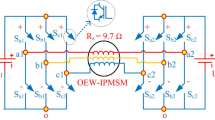Abstract
For an energy-efficient induction machine, the life-cycle cost (LCC) usually is the most important index to the consumer. With this target, the optimization design of a motor is a complex nonlinear problem with constraints. To solve the problem, the authors introduce a united random algorithm. At first, the problem is divided into two parts, the optimal rotor slots and the optimization of other dimensions. Before optimizing the rotor slots with genetic algorithm (GA), the second part is solved with TABU algorithm to simplify the problem. The numerical results showed that this method is better than the method using a traditional algorithm.
Similar content being viewed by others
References
Bland, J. A. and Dawson, G. P., 1991. Tabu search and design optimization.Computer Aided Design,23(3): 195–201.
Cheng, F. X. and Lin, J. M., 1993. Modern Design of Electrical Machines. Machine Building Press, Beijing (in Chinese).
Glover, F., 1989. Tabu search.ORSA J. Comput.,1 (3): 190–206.
Goldberg, D., 1988. Genetic Algorithms in Search, Optimization and Machine Learning. Addison-Wesley Publishing Company, USA.
Hamer, P. S., Lowe, D. M. and Wallace, S. E., 1997. Energy-efficient induction motors performance characteristics and life-cycle cost comparisons for centrifugal loads.IEEE Trans. on IA.,33(5): 1312–1320.
Hu, H. F., 1990. Tabu search with random moves for globally optimal design.Int. Journal Numer. Method Engineering,35: 1055–1070.
Liu, Y., Kang, L. S. and Chen, Y. P., 1995. The Parallel Algorithms for Nonnumerical Calculation (Vol.2)— Genetic Algorithm. Science Press, Beijing (in Chinese).
Ma, J. S., Liu, G. H. and Jia, Y. L., 1998. The big mutation: an operation to improve the performance of genetic algorithm.Control Theory and Applications,15 (3): 404–407 (in Chinese).
Madescu, G., Boldea, I. and Miller, T. J. E., 1998. The Optimal lamination approach to induction machine design global optimization.IEEE Trans. on IA.,34 (3): 422–428.
NEMA, 1993. Motors and Generators, No. MG 1. NEMA Standards Publ., Washington DC.
Yang, S. Y., Ni, G. Z. and Qian, J. G., 1998. Improved TABU search algorithm for numerical calculation of electromagnetic inverse problem of electrical machines.Proceedings of the CSEE,18 (2): 83–86 (in Chinese).
Author information
Authors and Affiliations
Corresponding author
Additional information
Project (No. 601299) supported by the Science Foundation of Hebei Province, China.
Rights and permissions
About this article
Cite this article
Fang, Yt., Fan, Cz., Ye, Yy. et al. Application of stochastic method to optimum design of energy-efficient induction motors with a target of LCC. J. Zhejiang Univ. Sci. A 4, 270–275 (2003). https://doi.org/10.1631/jzus.2003.0270
Received:
Accepted:
Published:
Issue Date:
DOI: https://doi.org/10.1631/jzus.2003.0270




